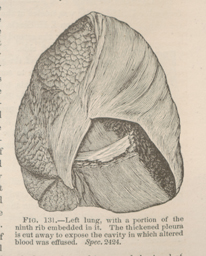Title: H——, H. C.
Source text: The Medical and Surgical History of the War of the Rebellion. (1861-65.), Part 2, Volume 2 (Washington, DC: Government Printing Office, 1876), 173.
Civil War Washington ID: med.d2e31739
TEI/XML: med.d2e31739.xml
CASE 562.—Private H. C. H——, Co. B. 1st Maine Heavy Artillery, wounded at the Wilderness, May 6, 1864, was sent to Washington, and entered Lincoln Hospital on May 26th. The symptoms are described only on the 30th and on June 2d: "A musket-ball wound, one inch below the inferior angle of the left scapula, enters the pleural cavity; there is no exit wound; the patient is very weak; the wound is unhealthy in appearance; a probe passes readily for a long distance through the wound; there is pyæmia; the respiration is hurried; there is considerable dulness on percussion over the left side; several sequestræ were removed from the scapula." On June 2d, there was "bloody oozing from orifice of the wound; no hæmorrhage from the mouth or bowels. Death, June 3, 1864, twenty-eight days after the reception of the wound. At the autopsy "a central portion of the ninth left rib, about two and three-fourths inches long (FIG. 130), was found broken off and driven into the substance of the left lung, having become firmly adherent to the lung by fibrinous bands (FIG. 131). The ball penetrated the left lung and diaphragm and was found flattened but concealed, because entirely encysted in the supra-renal capsule over the left kidney." It is erroneously stated in the minute in the First Surgical Volume that the ball penetrated both pleural cavities. The thoracic and abdominal were the two cavities penetrated. The lower lobe of the left lung was partly hepatized, partly carnified. The pulmonary and costal pleuræ were greatly thickened by profuse layers of lymph and false membrane. There had been hæmothorax, and the level of the dark decomposing grumous fluid was mapped out by stains on the serous sac (FIG. 131). The fragment of rib driven in upon the lung exactly supplies the loss of substance from the shaft of the bone. The three specimens were forwarded to the Museum by J. Cooper McKee, with the following memorandum: "Specimen 2423 exhibits the two extreme portions of the fractured rib; 2424 shows the middle portion of the rib attached to the left lung, which it has penetrated; 2425 is the upper part of the kidney with the supra-renal capsule, containing the ball itself, yet undisturbed. The ball penetrated the left lung and diaphragm and was found flattened and concealed, because entirely encapsulated in the supra-renal body."
 FIG. 129.—Section of the left kidney, with a colloidal musket ball lodged in the supra-renal capsule. Spec. 2425, A. M. M.
FIG. 129.—Section of the left kidney, with a colloidal musket ball lodged in the supra-renal capsule. Spec. 2425, A. M. M.

